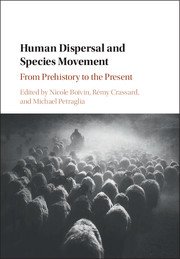Book contents
- Frontmatter
- Contents
- List of text boxes
- List of figures
- List of tables
- List of contributors
- Preface
- I Introduction
- II Origins: Species Movements in the Pleistocene
- 2 Carnivore guilds and the impact of hominin dispersals
- 3 Pleistocene hominin dispersals, naïve faunas and social networks
- 4 Hominins on the move: An assessment of anthropogenic shaping of environments in the Palaeolithic
- 5 Reconceptualising the palaeozoogeography of the Sahara and the dispersal of early modern humans
- III Across the water: Species movements by Coast and Sea
- IV Complexity: Species Movements in the Holocene
- V Invasion: The Movement of Invasive and Disease Species
- Index
- Plate section
- References
4 - Hominins on the move: An assessment of anthropogenic shaping of environments in the Palaeolithic
from II - Origins: Species Movements in the Pleistocene
Published online by Cambridge University Press: 04 May 2017
- Frontmatter
- Contents
- List of text boxes
- List of figures
- List of tables
- List of contributors
- Preface
- I Introduction
- II Origins: Species Movements in the Pleistocene
- 2 Carnivore guilds and the impact of hominin dispersals
- 3 Pleistocene hominin dispersals, naïve faunas and social networks
- 4 Hominins on the move: An assessment of anthropogenic shaping of environments in the Palaeolithic
- 5 Reconceptualising the palaeozoogeography of the Sahara and the dispersal of early modern humans
- III Across the water: Species movements by Coast and Sea
- IV Complexity: Species Movements in the Holocene
- V Invasion: The Movement of Invasive and Disease Species
- Index
- Plate section
- References
Summary
Abstract
Hominin dispersals in the Pliocene and Pleistocene have led to repeated range expansions of multiple human species, some with significant niche constructing behaviours. There is little doubt that humans have dramatically transformed global ecosystems since the adoption of agriculture by many societies in the Holocene. Beyond megafaunal extinctions, however, little attention has been paid to how pre-Holocene societies and our earlier hominin ancestors may have modified ecosystems as a consequence of subsistence-related activities and other pursuits. Evidence is reviewed here to demonstrate that the subsistence activities of hominins did in fact have an effect on local and regional environments as humans expanded their niches and territorial ranges in the Pliocene and Pleistocene. Evidence for the transformation of local ecologies in the Upper Palaeolithic of Europe is particularly convincing. Hominins also shaped their habitats through the use of fire and through the procurement and quarrying of raw materials for stone tool manufacture. Anthropogenic transformation of the natural world would appear to have begun in the Pliocene and Pleistocene, albeit on a different scale than in later periods.
Keywords: Human evolution, ecosystem, Palaeolithic, subsistence behaviour, landscape modification
INTRODUCTION
Humans today are shaping environments more than ever before in recorded history. The ways in which burgeoning human populations are contributing to the alteration of global climate and regional and local environments are the focus of investigation and interest by a diverse range of researchers, government organisations and policy makers. Most researchers have assumed that the transformation of Earth's climate and ecosystems by humans is largely a modern phenomenon. Yet, archaeologists and others are increasingly demonstrating that agricultural and pastoral societies significantly shaped environments over the course of the Holocene. While attention has thus been drawn to the ways in which human societies have altered global environments over the last 10,000 years, however, relatively little research has focused on studying how earlier human populations contributed to shaping ecosystems, beyond the intense debates surrounding the potential human contribution to the megafaunal extinctions that began ca. 50,000 years ago. Indeed, and perhaps somewhat surprisingly, Palaeolithic archaeologists have not yet made a concerted effort to examine the early anthropogenic transformation of ecosystems and physical landscapes, despite ethnographic observations suggesting that hunter-gatherers engaged in not insignificant environmental alteration.
- Type
- Chapter
- Information
- Human Dispersal and Species MovementFrom Prehistory to the Present, pp. 90 - 118Publisher: Cambridge University PressPrint publication year: 2017
References
- 6
- Cited by



